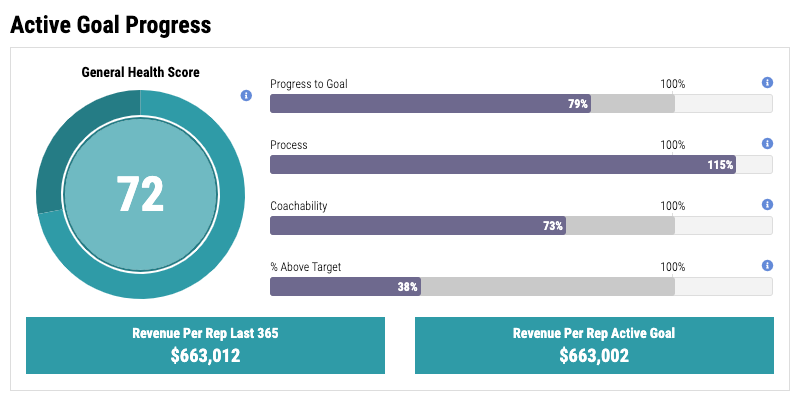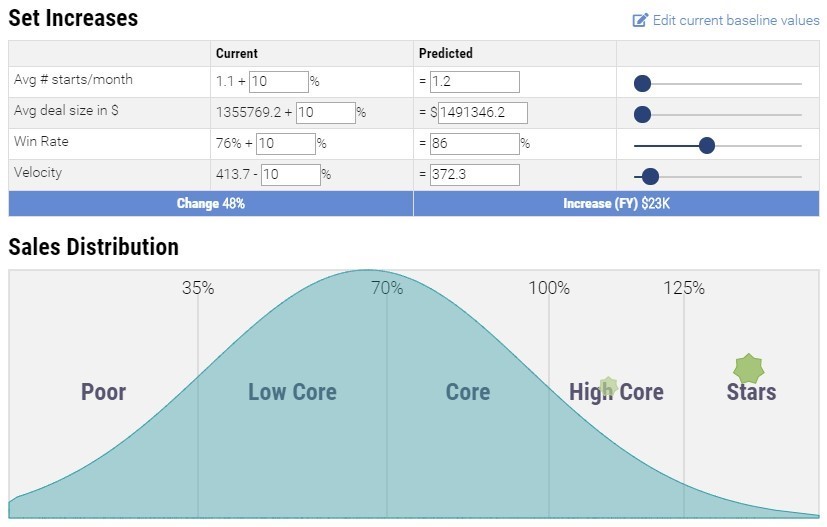By: Steve Jensen and Gary Rhoads
Sales KPIs or key performance indicators enable sales leaders to track team success and performance in meeting their performance objectives. These metrics help sales leaders make smarter decisions around improving sales performance, increasing the sales funnel, and reducing the length of the sales cycle. By measuring the right sales KPIs, you can optimize your sales process and ensure your sales teams are prioritizing the right activities for the greatest success.
According to Hubspot, The 5 Most Important Sales Performance Metrics Every Rep and Manager Should Track are as follows:
- Percentage of sales team hitting quota
- Average deal size
- Conversion/win rate
- Revenue
- Sales funnel leakage
When it comes to understanding the impact of a sales leader on team performance, it is interesting to note that Revenue per Rep didn’t even make the top 5. In fact, an exhaustive search of Google for Sales KPIs doesn’t yield a single reference to Revenue per Rep—astounding given its importance and the amount of information about a sales program that it contains. There are a myriad of KPI lists available to aid sales leaders in understanding the performance of their teams, but presently, RPR seems to be overlooked.
As we work with sales leaders around the world, we’ve found that changes in Revenue per Rep (RPR) is an essential performance indicator for assessing the impact of a leader on sales team performance. As a bottom-line indicator, RPR answers the key question, “as a leader, am I helping each rep get better and improve over time?” As organizations strive to get more out of the reps they hire, RPR is becoming a “must-have” metric for large sales organizations. However, our experience shows this metric is little understood and only recently being used by top enterprise sales organizations. This seems odd given the insight this metric provides and its usefulness in managing a sales team. Is RPR worth measuring?
Managers who focus on Revenue per Rep note that the RPR KPI measures the ability of each of your sales reps or sales teams to generate revenue for your organization. It allows sales leaders to evaluate at the employee level what kind of revenue was generated per rep. Leaders also report that RPR helps them assess the effectiveness of their monthly or weekly 1;1s by establishing a sales baseline and in determining the strengths and weaknesses of each rep.
Using RPR
Adding revenue per rep will provide a more granular look at your sales operations.
RPR should be used as a performance tool to foster improvement and growth within your team. It works well as an overall assessment because it ties directly to compensation, which is most important to the rep, and to ROI, which is most important to the sales leader.
Providing ubiquitous access to this KPI may help foster competition amongst your team. However, according to Klipfolio, “One of the most important components of this KPI is to establish a baseline when comparing your sales reps. Not all sales reps are created equally (so to speak) and your baseline should account for differences such as seniority, location, and whether they are inbound or outbound sales.”
RPR in Coaching
RPR can be helpful in establishing a sales baseline (and setting personal goals) and in determining the strengths and weaknesses of each rep. RPR also reflects the efficiency of training and coaching. This makes it perfect for establishing performance goals that are realistic, achievable and relevant.
RPR isn’t about activity goals; it is about overall results and is a good indicator of overall success. For example, if RPR has slipped, it could be due to excessive discounting and goals could be set around decreasing discounts. In an individual case, if a rep’s individual revenue has slipped below the average, goals could be set based on factors that affect that rep’s performance.
Xvoyant’s Approach

Xvoyant RPR Screen
Xvoyant tracks RPR automatically, breaks it down into a total for the past year and shows it in relation to the team’s active goal. This is particularly helpful when setting new revenue goals.
Using Xvoyant’s built-in “What If” calculator allows a sales leader to compare a rep’s revenue with the average RPR of a team to measure individual performance against the group. A set of sliders lets you change various factors that contribute to a rep’s revenue and see the effect of those changes. This makes goal setting even easier.
For example, you can change a rep’s win rate and see what effect it will have on his or her projected revenue. Then, the sales leader can set a goal around improving win rate, knowing exactly what the results will be.

Xvoyant “What If” Calculator
Conclusion
Today’s sales leaders know that having consistency and structure are some of the most important aspects of a coaching system. Having a baseline metric like RPR that your reps understand and can easily track in Salesforce make things much easier for your sales reps and it has the side benefit for you, as a sales manager, to clearly articulate and define your organization’s processes and expectations. This certainly will have positive effects on the rest of the sales team.
Adding RPR to the mix is easy and having it as a part of your dashboard will keep it top-of-mind. Using it as foundational information for 1 on 1 preparation and “how good can you get” conversations will lead to productive and efficient coaching sessions.
So, make sure you know how much each of your reps is contributing to your overall revenue. RPR is a powerful tool that shouldn’t be overlooked.
————————————————-
Steve Jensen is VP of Marketing at Xvoyant. You can follow him on LinkedIn.
Gary Rhoads is Co-Founder and Chairman of the Board at Xvoyant.